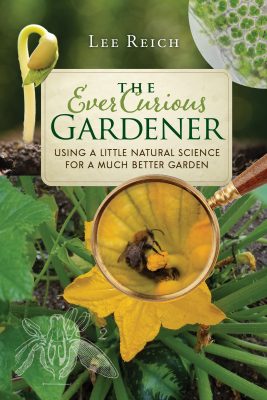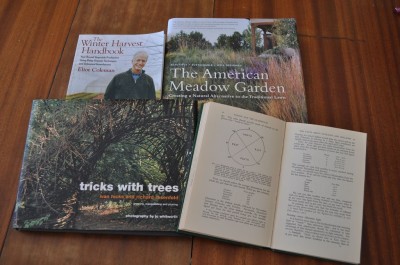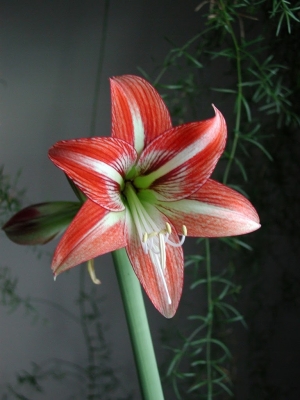Gardening by the Book
An outdoor temperature of 8.2 degrees Fahrenheit this morning highlighted what a great time winter is for NOT gardening, but for reading about gardening. A lot of gardening books, new and old, end up on my bookshelves, and I’d like to note a few favorites new to my shelves last year.
(Disclaimer: I had a new book published last year, The Ever Curious Gardener — available here. I like the book very much.)

For anyone serious about vegetable growing, Eliot Coleman, gardener extraordinaire, is the author to seek out. The Winter Harvest Handbook builds on his The New Organic Grower (recently re-issued to celebrate its 30th year since publication!) and Four Season Harvest, delving into innovative techniques for growing vegetables more efficiently and year ‘round, with minimum heat inputs even in northern climates.
The “aha” moment for me in reading Eliot’s method’s for year ‘round harvests was that sunlight, even this far north, is not limiting plant growth in winter. New York City and Madrid are at the same latitude! Mediterranean gardeners don’t abandon their vegetable gardens in winter; they just change plants, growing vegetables, such as spinach, lettuce, cabbage, and radish, that tolerate and enjoy cold weather. What we need on this – the cold side – of the big pond are ways to contain the earth’s heat and/or to provide heat efficiently to keep plants alive and growing. Read the book.

The title of the book Tricks with Trees, by Ivan Hicks and Richard Rosenfeld, doesn’t do justice to the neat things shown that people have done, and you could do, with trees. How about a tree trained as a chair, a living chair? Don’t expect to move such a chair anywhere because it’s rooted in the ground. One of my other favorites in the book is the “cloud seat.” (Use your imagination and you might guess what this is.)
People love the idea of meadows, perhaps because meadows seem low maintenance, perhaps because humans originated in the savannahs of Africa. Meadows have become very popular over the last few decades, and lots has been written about them. (I even have a meadow section in my book Weedless Gardening.) The American Meadow Garden, by John Greenlee, offers all you need to know and to grow a meadow. Saxon Holt’s photographs were so inspiring I contemplated turning my one-acre meadow into, well, more of a meadow. After seeing the photograph on page 41, I want shooting stars, a milkweed relative, in my meadow, which gets nothing much more than a yearly mowing.
Greenlee’s book does keep you grounded with plenty of information about the plants, about preparing the ground, and about maintenance, especially weed control. Maintenance? Weed control? Yes, a meadow, depending on your aspirations, may need both. My only beef with this book is that Greenlee makes no mention of mowing with a scythe, a most pleasant and very efficient tool for meadow maintenance.
Last, but certainly not least, is Science and the Glasshouse by William Lawrence. If the title sounds a bit old-fashioned, it’s because the book is old-fashioned; it was written in 1950. I visited Eliot Coleman this past summer and sometime during the visit we were lobbing titles of our favorite books back and forth. He threw me this one after I had lobbed to him Intensive Gardening, by Rosa O’Brien, also 1950 vintage and one of my favorite gardening books of all time (and one he had suggested to me back in 1973).
Back to Science and the Glasshouse, which I ordered asap, actually asaicgo (as soon as I could get online). My favorite thing about this book is that it challenges many commonly held notions by testing them scientifically. Mr. Lawrence, then head of the Garden Department of the acclaimed John Innes Horticultural Institute in Britain, subjected to scientific inquiry such beliefs as: cold soil is harmful to potted seedlings (it is not); crowding potted plants decreases growth of individual plants (sometimes); size matters, in pots for transplants (yes), and so on.
The second half of the book is devoted to the “glasshouse,” which greenhouses literally were back then. Mostly, his testing showed that plants in greenhouses did not always get all the light they should, not because of a lackadaisical old sol but because of dirty glass, poor orientation, and other things we can control. Which brings us around full circle back to Eliot Coleman’s capitalizing on winter sunlight.
Some Dirt Under the Fingernails
Okay, I am, in fact, doing a little gardening. I went down to the basement and brought 2 amaryllis plants upstairs to get them started growing for blossoms in February(?).



Please add TEAMING WITH MICROBES to your list of good books! One of the most interesting and informative books I have read and reread! It has changed my way of working in the garden, as has your book WEEDLESS GARDENING.
I agree. Everyone should read TEAMING WITH MICROBES. Also Jeff’s other books.
asaicgo!
haha.
???? Please translate.
Have you seen Niki Jabbour’s book , The Year Round Vegetable Gardener about growing veggies year round in Nova Scotia, Canada , really interesting and full of great ideas
I’ll check it out.